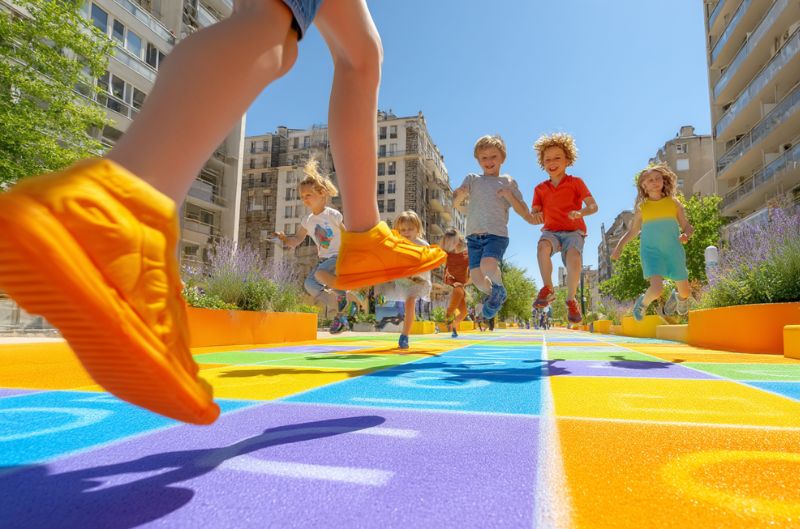
How Historical Playground Games Shape Childhood Experiences
Author: Austin Stanfel
Playground games have been a cornerstone of childhood for centuries, evolving across generations and cultures while retaining their core functions: fostering physical activity, social development, creativity, and resilience. From ancient hopscotch courts to digital play spaces, the legacy of historical playground games continues to influence how children play, learn, and grow today.
The Enduring Appeal of Traditional Playground Games
Classic playground games such as tag, hide and seek, hopscotch, and marbles have roots stretching back hundreds, sometimes thousands, of years. For instance, hopscotch can be traced to Roman-ruled England, where soldiers used long courses to build agility in armor, and the game later morphed into a children’s pastime with “scotches” (scratches) marking the play area. Marbles have been found in ancient Egyptian and Aztec ruins, while jacks—called initially “knucklebones”—date back to ancient Greece.
Despite their age, these games remain popular, albeit with local variations and evolving rules. Their longevity is partly due to their simplicity and adaptability. They require minimal equipment and easily learned rules, making them accessible to children in diverse settings.
Transmission of Play: Oral Tradition and Adaptation
The persistence of playground games is primarily attributed to oral tradition. Children pass down the rules and variations of games from generation to generation, often modifying them to suit their environment or cultural context. This process of adaptation ensures that games remain relevant and engaging.
For example, clapping games and rhymes have incorporated contemporary pop culture references, while the core mechanics remain unchanged.
The communal authorship of playground games also teaches children about negotiation, consensus, and the value of tradition. As documented in studies of schoolyard play, children often debate rule changes, invoking the “history” of their games to assert continuity and group identity.
Developmental Benefits: Physical, Social, and Cognitive Growth
Historical playground games are more than just entertainment—potent tools for holistic child development:
Physical Development: Games like hopscotch, tag, and sack races promote gross motor skills, balance, coordination, and physical fitness. These activities encourage children to move, jump, run, and develop spatial awareness in ways that structured sports or sedentary play cannot.
Social Skills: Traditional games require cooperation, turn-taking, communication, and conflict resolution. Studies have shown that participating in these games enhances children’s social development, including self-help, self-regulation, and peer interaction. Children learn to navigate rules, handle winning and losing, and build friendships through play.
Cognitive and Emotional Growth: Many playground games involve strategy, memory, and problem-solving, fostering cognitive flexibility and creativity. Traditional play’s unstructured nature allows children to invent or modify new games, stimulating imagination and innovation.
Emotional Intelligence: Children develop resilience and emotional intelligence by coping with frustration, practicing patience, and experiencing victory and defeat.
The Evolution of Playgrounds and Play Spaces
While the games have ancient origins, the concept of dedicated playgrounds is relatively modern. In the 19th century, sand pits and outdoor gymnasiums emerged in Germany and the United States, reflecting a growing recognition of the importance of play in child development. Over time, playgrounds have become standard features of communities, designed to offer safe environments for free, unstructured play.
Modern playgrounds continue to evolve, incorporating inclusive designs, natural elements, and even digital technologies to accommodate diverse needs and interests. However, there is an ongoing debate about the balance between safety and challenge—overly sanitized playgrounds may limit opportunities for risk-taking and self-discovery, which are integral to the benefits of traditional play.
If you want to explore more about historical playgrounds, check out our article on banned 1970s playground equipment.
Challenges and the Future of Traditional Games
Despite their many benefits, traditional playground games face challenges in the modern era. Urbanization, increased traffic, and safety concerns have reduced opportunities for street play, leading to a greater reliance on adult-organized activities and digital entertainment. As a result, some games are less commonly played, and adults sometimes intervene to “teach” traditional games, which can inadvertently stifle the organic, child-led nature of play.
Nonetheless, there is a growing movement to preserve and revitalize traditional playground games, recognizing their value in promoting healthy, well-rounded childhoods. Schools and community organizations are reintroducing classic games, encouraging children to explore their heritage and invent new variations.
Conclusion
Historical playground games are much more than relics of the past—they are living traditions that continue to shape modern children’s experiences, skills, and identities. By fostering physical health, social competence, creativity, and resilience, these games provide a foundation for lifelong learning and well-being. As society navigates the challenges of the digital age, the enduring appeal and developmental value of traditional playground games remind us of the timeless importance of play in childhood.

